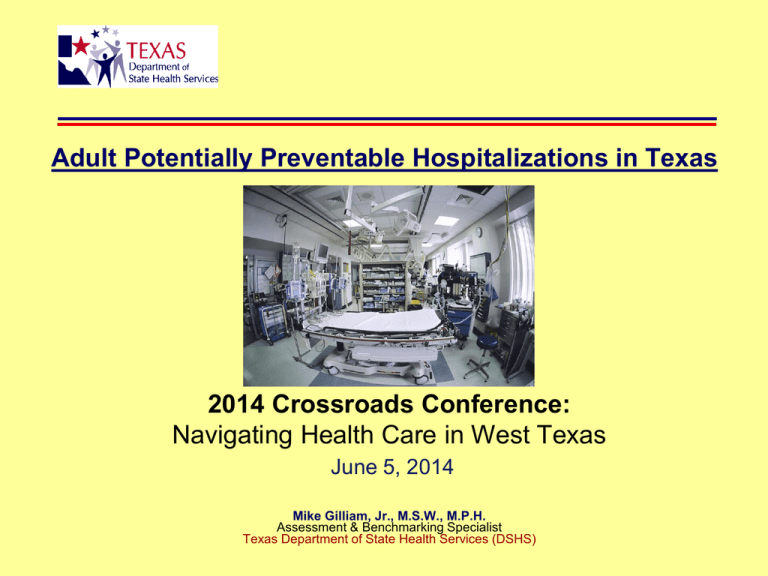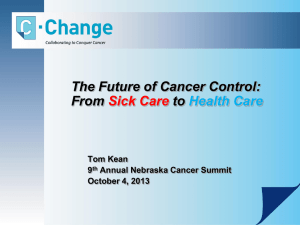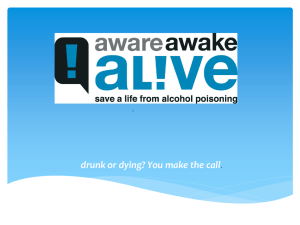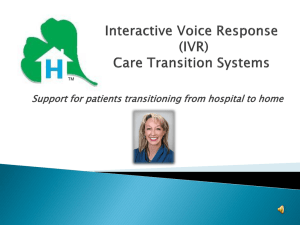
Adult Potentially Preventable Hospitalizations in Texas
2014 Crossroads Conference:
Navigating Health Care in West Texas
June 5, 2014
Mike Gilliam, Jr., M.S.W., M.P.H.
Assessment & Benchmarking Specialist
Texas Department of State Health Services (DSHS)
Adult Potentially Preventable Hospitalizations
in Texas (2007-2012)
• Since 2008, DSHS has educated communities and policymakers on the impact of
these ten adult potentially preventable hospitalization conditions:
1. Bacterial Pneumonia;
2. Dehydration;
3. Urinary Tract Infection (UTI);
4. Angina (without procedures);
5. Congestive Heart Failure (CHF);
6. Hypertension;
7. Asthma;
8. Chronic Obstructive Pulmonary Disease (COPD);
9. Diabetes Short-term (ST) Complications; and
10. Diabetes Long-term (LT) Complications.
Adult hospitalizations for these conditions are considered “potentially preventable,”
because if the individual had access to and cooperated with appropriate
outpatient healthcare, the hospitalization would likely not have occurred.
Page 2
Adult Potentially Preventable Hospitalizations
in Texas (2007-2012)
Bacterial Pneumonia is a serious inflammation of the lungs caused by an infection. Bacterial pneumonia
primarily impacts older adults. Communities can potentially prevent hospitalizations by encouraging older adults
and other high risk individuals to get vaccinated for bacterial pneumonia.
Dehydration means the body does not have enough fluid to function well. Dehydration primarily impacts older
adults or institutionalized individuals who have a limited ability to communicate thirst. Communities can
potentially prevent hospitalizations by encouraging attention to the fluid status of individuals at risk.
UTI is usually caused when bacteria enter the bladder and cause inflammation and infection. It is a common
condition, with older adults at highest risk. In most cases, an uncomplicated UTI can be treated with proper
antibiotics. Communities can potentially prevent hospitalizations by encouraging individuals to practice good
personal hygiene; drink plenty of fluids; and (if practical) avoid conducting urine cultures in asymptomatic
patients who have indwelling urethral catheters.
Angina (without procedures) is chest pain that occurs when a blockage of a coronary artery prevents sufficient
oxygen-rich blood from reaching the heart muscle. Communities can potentially prevent hospitalizations by
encouraging regular physical activity; smoking cessation; controlling diabetes, high blood pressure, and
abnormal cholesterol; maintaining appropriate body weight; and daily administration of an anti-platelet
medication (like low dose aspirin) in most individuals with known coronary artery disease.
CHF is the inability of the heart muscle to function well enough to meet the demands of the rest of the body.
Communities can potentially prevent hospitalizations by encouraging individuals to reduce risk factors such as
coronary artery disease, diabetes, high cholesterol, high blood pressure, smoking, alcohol abuse, and use of
illegal drugs.
Page 3
Adult Potentially Preventable Hospitalizations
in Texas (2007-2012)
Hypertension is a syndrome with multiple causes. Hypertension is often controllable with medications. Communities can
potentially prevent hospitalizations by encouraging an increased level of aerobic physical activity, maintaining a healthy
weight, limiting the consumption of alcohol to moderate levels for those who drink, reducing salt and sodium intake, and
eating a reduced-fat diet high in fruits, vegetables, and low-fat dairy food.
Asthma occurs when air passages of the lungs become inflamed and narrowed and breathing becomes difficult. Asthma is
treatable, and most flare-ups and deaths can be prevented through the use of medications. Communities can potentially
prevent hospitalizations by encouraging people to learn how to recognize particular warning signs of asthma attacks. Treating
symptoms early can result in prevented or less severe attacks.
COPD is characterized by decreased flow in the airways of the lungs. It consists of three related diseases: asthma, chronic
bronchitis and emphysema. Because existing medications cannot change the progressive decline in lung function, the goal of
medications is to lessen symptoms and/or decrease complications. Communities can potentially prevent hospitalizations by
encouraging education on smoking cessation and minimizing shortness of breath.
Diabetes ST Complications are extreme fluctuations in blood sugar levels. Extreme dizziness and fainting can indicate
hypoglycemia (low blood sugar) or hyperglycemia (high blood sugar), and if not brought under control, seizures, shock or
coma can occur. Diabetics need to monitor their blood sugar levels carefully and adjust their diet and/or medications
accordingly. Communities can potentially prevent hospitalizations by encouraging the regular monitoring and managing of
diabetes in the outpatient health care setting and encouraging patient compliance with treatment plans.
Diabetes LT Complications include risk of developing damage to the eyes, kidneys and nerves. Risk also includes
developing cardiovascular disease, including coronary heart disease, stroke, and peripheral vascular disease. Long-term
diabetes complications are thought to result from long-term poor control of diabetes. Communities can potentially prevent
hospitalizations by encouraging the regular monitoring and managing of diabetes in the outpatient health care setting and
encouraging patient compliance with treatment plans.
Page 4
Adult Potentially Preventable Hospitalizations
in Texas (2007-2012)
• Methodology to identify “Potentially Preventable Hospitalizations” was
developed by the Agency for Healthcare Research and Quality (AHRQ).
AHRQ is the lead federal agency responsible for research on healthcare
quality costs, outcomes and patient safety.
• Potentially Preventable Hospitalizations are also referred to as Ambulatory
Sensitive Conditions, Prevention Quality Indicators and/or Potentially
Preventable Admissions/Events.
• Potentially Preventable Hospitalization data is based on primary diagnosis.
• Potentially Preventable Hospitalization data is based on county of
residence – not the county where the individual was hospitalized.
Page 5
Adult Potentially Preventable Hospitalizations
in Texas (2007-2012)
• The purpose of this information is to assist in improving healthcare and
reducing healthcare costs.
• This information is not an evaluation of hospitals or other healthcare
providers.
• This information can be used as a tool to assess a community’s
outpatient healthcare system.
• Inpatient hospital data in Texas is available from the Texas Health Care
Information Collection (www.dshs.state.tx.us/thcic), in the Center for
Health Statistics, at DSHS.
Page 6
Adult Potentially Preventable Hospitalizations
in Texas (2007-2012)
• *From 2007-2012, adult residents of Texas received approximately
$47.4 Billion (B) in charges for 1,459,249 hospitalizations that
were potentially preventable.
• *$47.4 B equals $2,483 for every adult Texan.
• *Allocation of the $47.4 B by Expected Primary Source of Payment:
...Medicare
$30.0 B (63.3%)
…Private Health Insurance
$ 8.5 B (18.0%)
…Uninsured
$ 4.6 B (09.7%)
…Medicaid
$ 3.2 B (06.8%)
…Other
$ 1.1 B (02.2%)
*Combination of ten adult potentially preventable hospitalization conditions (2007-2012).
Page 7
Adult Potentially Preventable Hospitalizations
in Texas (2007-2012)
• *Number of Hospitalizations:
1,459,249
• *Average Hospital Charge:
$32,464
• *Average Length of Hospital Stay:
4.9 Days
• *Average Age of Individual Hospitalized:
63 Years
*Combination of ten adult potentially preventable hospitalization conditions (2007-2012).
Page 8
Adult Potentially Preventable Hospitalizations
in Texas (2007-2012)
Diabetes
LT
Diabetes
ST
COPD or
Older Adult
Asthma
Hypertension
CHF
Angina
w/o procedures
UTI
Dehydration
Hospitalizations
Bacterial
Pneumonia
Adult
Residents of
Texas
(2007-2012)
293,857
94,531
205,318
15,762
338,497
65,962
252,777
59,617
132,928
Female
55.8%
62.4%
74.6%
55.2%
51.6%
62.8%
62.4%
51.7%
47.1%
Male
44.2%
37.6%
25.4%
44.8%
48.4%
37.2%
37.6%
48.3%
52.9%
White
72.6%
71.3%
69.0%
66.4%
63.7%
49.8%
74.2%
53.6%
53.4%
Black
10.2%
11.3%
10.9%
14.0%
18.4%
31.1%
13.0%
25.2%
19.4%
Other (Race)
17.0%
17.0%
19.8%
18.5%
17.6%
18.9%
12.5%
21.1%
27.0%
Hispanic
19.1%
19.9%
24.3%
23.4%
21.6%
23.4%
13.8%
26.7%
36.0%
*Values of less than 3% are included in “Other”
Texas (U.S. Census 2010, Adult Population)
White (Race): 72.2% Black (Race): 11.6%
Other (Race): 16.2%
Hispanic (Ethnicity): 33.6%
Page 9
Adult Potentially Preventable Hospitalizations
in Texas (2007-2012)
Diabetes
ST
Diabetes
LT
COPD or
Older Adult
Asthma
293,857
94,531
205,318
15,762
338,497
65,962
252,777
59,617
132,928
Average Age
65 Years
64 Years
65 Years
58 Years
68 Years
58 Years
67 Years
38 Years
57 Years
HyperTension
CHF
Hospitalizations
UTI
Angina
w/o
Procedures
Dehydration
Bacterial
Pneumonia
Adult
Residents of
Texas
(2007-2012)
Age
18-19 Years
6.5%
20-29 Years
6.2%
30-39 Years
3.2%
6.2%
24.2%
4.8%
19.4%
7.9%
40-49 Years
8.1%
8.8%
7.3%
16.6%
3.6%
16.8%
9.5%
19.8%
16.2%
50-59 Years
13.6%
13.4%
9.7%
26.8%
13.2%
21.4%
19.0%
16.0%
24.6%
60-69 Years
17.4%
16.5%
12.9%
23.0%
20.2%
18.3%
26.0%
8.1%
22.3%
70-79 Years
22.1%
20.9%
20.2%
16.5%
25.0%
16.8%
26.8%
15.9%
80-89 Years
23.1%
21.7%
26.7%
10.0%
25.8%
13.7%
16.2%
9.0%
90+ Years
7.6%
6.9%
9.4%
7.7%
3.1%
Other
8.3%
8.7%
1.3%
4.5%
5.1%
7.1%
*Values of less than 3% are included in “Other”
Page 10
2.5%
6.0%
4.2%
Adult Potentially Preventable Hospitalizations
in Texas (2007-2012)
15,762
338,497
65,962
252,777
59,617
132,928
Home/Self-Care
61.6%
68.2%
57.8%
77.0%
59.9%
84.2%
71.8%
86.3%
59.8%
Skilled Nursing
Facility
11.5%
10.7%
17.8%
10.4%
3.5%
6.7%
Home Health
10.7%
9.6%
11.6%
14.7%
6.7%
11.5%
Diabetes
LT
Diabetes
ST
205,318
Hyper –
Tension
94,531
CHF
293,857
Hospitalizations
UTI
COPD or
Older Adult
Asthma
Angina
w/o procedures
Dehydration
Bacterial
Pneumonia
Adult
Residents of
Texas
(2007-2012)
Discharged to
Intermediate
Care Facility
3.1%
8.7%
4.3%
3.9%
ST Hospital
12.5%
Medicare
Certified LT
Hospital
5.9%
Left Against
Medical Advice
Died
Other
16.4%
3.5%
3.3%
12.7%
11.2%
8.8%
7.1%
*Values of less than 3% are included in “Other”
Page 11
14.7%
5.2%
9.8%
5.7%
9.0%
Adult Potentially Preventable Hospitalizations
in Texas (2007-2012)
15,762
338,497
65,962
252,777
59,617
132,928
Medicare
65.1%
61.5%
66.2%
45.0%
73.5%
46.2%
66.8%
20.0%
53.5%
Private Health
Insurance
19.6%
24.8%
16.2%
32.5%
12.0%
25.1%
16.6%
29.1%
20.4%
Uninsured
8.0%
6.6%
9.2%
12.4%
6.9%
18.2%
7.3%
32.1%
13.2%
Medicaid
5.4%
5.0%
6.4%
6.1%
5.9%
7.2%
7.2%
13.9%
10.0%
Other
1.9%
2.1%
1.9%
4.1%
1.7%
3.2%
2.1%
4.9%
2.9%
Avg. Length of
Hospital Stay
5.4 days
3.6 days
4.3 days
2.3 days
5.3 days
3.2 days
4.6 days
3.7 days
6.7 days
Avg. Hospital
Charge
$34,736
$19,984
$23,880
$22,962
$40,252
$23,952
$29,738
$25,275
$43,505
Total Approximate
Hospital Charges
$10.2 B
$1.9 B
$4.9 B
$361.9 M
$13.6 B
$1.6 B
$7.5 B
$1.5 B
$5.8 B
Diabetes
LT
Diabetes
ST
205,318
Hyper –
tension
94,531
CHF
293,857
Hospitalizations
UTI
COPD or
Older Adult
Asthma
Angina
w/o procedures
Dehydration
Bacterial
Pneumonia
Adult
Residents of
Texas
(2007-2012)
Expected Primary
Source of
Payment
*Values of less than 3% are included in “Other”
B means Billion
Page 12
M means Million
Adult Potentially Preventable Hospitalizations
in Texas (2007-2012)
Combined, Bacterial Pneumonia and CHF comprise:
• *43.3% (632,354) of admissions for Potentially
Preventable Hospitalizations; and
• *50.2% ($23.8 B) of charges for Potentially
Preventable Hospitalizations.
*Combination of ten adult potentially preventable hospitalization conditions (2007-2012).
Page 13
Adult Potentially Preventable Hospitalizations
in Texas
Secondary Diagnosis of Mental Illness/Substance Abuse in
Adult Potentially Preventable Hospitalizations in Texas (2006-2010)
Adult
Residents of
Texas
(2006-2010)
Hospitalizations
*Mental Illness/
Substance
Abuse
(Secondary
Diagnosis)
Bacterial
Pneumonia
Dehydration
UTI
Angina
CHF
250,721
68,557
160,599
14,984
296,953
51,817
77,900
*32.5%
*31.0%
*36.1%
*31.3%
*20.6%
*30.9%
*37.0%
w/o procedures
HyperTension
Asthma
COPD
Diabetes
ST
Diabetes
LT
145,200
45,192
108,078
*44.4%
*29.3%
*20.3%
For example, 32.5% of the 250,721 adult potentially preventable hospitalizations for Bacterial
Pneumonia (2006-2010) had a secondary diagnosis of mental illness/substance abuse.
*Alcohol and other Drug Diagnoses (Excluding Tobacco Use Disorder) are Significantly
Underrepresented Due to Data Suppression Requirements.
Page 14
Adult Potentially Preventable Hospitalizations
in Texas (2007-2012)
Page 15
Adult Potentially Preventable Hospitalizations
in Texas (2007-2012)
In-depth data profiles are available with the following information:
Years (2007-2012);
Condition (Ten Conditions);
County;
Age Group;
Sex;
Race;
Ethnicity;
Zip Code of Residence;
Hospitalized at;
Average Length of Hospital Stay;
Average Hospital Charge;
Total Hospital Charges;
Discharged to; and
Expected Primary Source of Payment.
To request an in-depth profile, send an email to mike.gilliam@dshs.state.tx.us.
Page 16
Adult Potentially Preventable Hospitalizations
in Texas (2007-2012)
Example of In-Depth Data Profile:
LUBBOCK COUNTY: Adult Residents
Diabetes Short-term Complications Potentially Preventable Hospitalizations (2007-2012)
Total Hospitalizations
1,133
Age
18-19 Years
20-29 Years
30-39 Years
40-49 Years
50-59 Years
60-69 Years
Other
04.2%
32.4%
19.8%
16.4%
12.8%
08.5%
05.9%
Female
Male
49.4%
50.6%
White (Race)
Black (Race)
Other (Race)
70.7%
*19.4%
09.9%
Hispanic (Ethnicity)
*39.3%
Zip Code of Residence
79403
79416
79423
79411
79415
79407
79412
79413
79424
79414
79404
79401
Other
*The adult (18+) population of Lubbock County is
approximately 09.0% Black and 28.6% Hispanic.
Page 17
13.2%
09.5%
07.8%
07.8%
07.7%
07.6%
07.1%
06.5%
06.2%
05.6%
05.6%
05.6%
03.6%
Adult Potentially Preventable Hospitalizations
in Texas (2007-2012)
Example of In-Depth Data Profile:
LUBBOCK COUNTY: Adult Residents
Diabetes Short-term Complications Potentially Preventable Hospitalizations (2007-2012)
Total Hospitalizations
1,133
Place of Hospitalizations
University Medical Center
Covenant Medical Center
Other
68.0%
26.3%
05.8%
Average Length of Stay
Average Hospital Charge
4.3 Days
$26,694
Total Hospital Charges
$30,244,581
Expected Primary Source of Payment
Medicaid
Medicare
Private Health Insurance
Uninsured
Other
17.9%
22.7%
23.7%
32.5%
03.2%
Discharged to
Home/Self Care
Home Health
Skilled Nursing Facility
Other
Page 18
87.0%
05.2%
03.1%
04.2%
Adult Potentially Preventable Hospitalizations
in Texas (2007-2012)
Efforts to Reduce Adult Potentially Preventable Hospitalizations
The 82nd Texas Legislature appropriated $2 M for DSHS to implement the Reducing
Adult Potentially Preventable Hospitalizations Initiative in FY 12/13.
DSHS contracted with 16 counties to implement evidence-based interventions, through
a community coordinated approach, to reduce hospitalizations and/or hospital
charges among adult county residents for selected potentially preventable
hospitalization conditions. Adult residents in each of the 16 counties had a
hospitalization rate more than 50% higher than the state rate from 2005-2009.
Each of the 16 counties had a Project Contact that coordinates monthly coalition
meetings to maximize implementation of one or more of the following evidence-based
interventions: immunizations; patient education; community education; smoking
cessation; healthcare provider education; diabetes self-management education; patient
case management; nutrition & physical activity; weight management; glycemic control;
and blood pressure control.
Page 19
Adult Potentially Preventable Hospitalizations
in Texas (2007-2012)
Page 20
Adult Potentially Preventable Hospitalizations
in Texas (2007-2012)
FY12/13 Reducing Adult Potentially Preventable Hospitalizations Initiative (01/01/12 – 08/31/13)
County
Angelina
Hospitalization Condition(s)
Bacterial Pneumonia, Dehydration & UTI
Project Contact
Sharon Shaw (Angelina Co. & Cities Health District)
sshaw@acchd.us
Brooks
Bacterial Pneumonia
Diana Bill (Community Action Corp. of S TX)
diana.bill@cacost.org
Ector
Asthma & COPD
Sherrill Rhodes (Medical Ctr. Health System)
srhodes@echd.org
Grayson
Bacterial Pneumonia, Dehydration & UTI
John Teel (Grayson Co. Health Dept.)
teelj@co.grayson.tx.us
Hunt
Bacterial Pneumonia & COPD
Pam Andrews (Hunt Co. Health Dept.)
pandrews@huntcounty.net
Liberty
Bacterial Pneumonia, CHF & COPD
Steven Racciato (Health Ctr. of SE TX)
fqhc1@sbcglobal.net
Limestone
Bacterial Pneumonia & CHF
Kimberly Meyer (Limestone Medical Ctr.)
kmeyer@lmchospital.com
Nacogdoches
Dehydration & UTI
Kinnie Douglas (Nacogdoches Memorial Hospital)
douglask@nacmem.org
Orange
Bacterial Pneumonia, CHF & COPD
Jarren Garrett (Baptist Hospitals of SE TX – Orange)
jarren.garrett@bhset.net
Polk
Bacterial Pneumonia, CHF & COPD
Jerry Hathorn (Polk Co. Health Advisory Coalition)
jerry.hathorn@dshs.state.tx.us
Red River
CHF & COPD
Marleah Drew (Lennox Health Resources)
mdlennoxhrc@cebridge.net
San Augustine
Bacterial Pneumonia
Sharon Shaw (Angelina Co. & Cities Health District)
sshaw@acchd.us
Tom Green
Bacterial Pneumonia, UTI & COPD
Dianna Spieker (Tom Green Co.)
dianna.spieker@co.tom-green.tx.us
Trinity
Bacterial Pneumonia, UTI & COPD
Carl Dyer (Trinity Co.)
carl.dyer@co.trinity.tx.us
Victoria
Bacterial Pneumonia, CHF & Diabetes
robbyn.michalka@victoriacollege.edu
Walker
Hypertension & Diabetes
Robbyn Michalka (Texas AHEC East – Victoria
Region)
Meredith Henry (Texas AgriLife – Walker Co.)
Page 21
Email
mdhenry@ag.tamu.edu
Adult Potentially Preventable Hospitalizations
in Texas (2007-2012)
FY14/15 Reducing Adult Potentially Preventable Hospitalizations Initiative (09/01/13 – 08/31/15)
DSHS re-contracted with 13 of the 16 counties funded in FY12/13.
County
Angelina
Project Contact
Ann Watson (Angelina Co. & Cities Health District)
awatson@acchd.us
Brooks
Hospitalization Condition(s)
Bacterial Pneumonia, Dehydration, UTI &
Hypertension
Bacterial Pneumonia & Dehydration
Diana Bill (Community Action Corp. of S TX)
diana.bill@cacost.org
Ector
Asthma, COPD & Diabetes
Dianna Ruiz (Medical Ctr. Health System)
dhuerta@echd.org
Grayson
Bacterial Pneumonia, Dehydration, UTI &
COPD
Bacterial Pneumonia , CHF & COPD
Sandra Clark (Grayson Co. Health Dept.)
sandrac@co.grayson.tx.us
Kimberly Meyer (Limestone Medical Ctr.)
kmeyer@lmchospital.com
Jarren Garrett (Baptist Hospitals of SE TX – Orange)
jarren.garrett@bhset.net
Jerry Hathorn (Polk Co. Health Advisory Coalition)
jerry.hathorn@dshs.state.tx.us
Red River
Bacterial Pneumonia, Angina, CHF &
COPD
Bacterial Pneumonia, Dehydration, CHF
& COPD
CHF, COPD & Diabetes
Tammy Lawing (Lennox Health Resources)
tglawing@etmc.org
San Augustine
Bacterial Pneumonia & Hypertension
Ann Watson (Angelina Co. & Cities Health District)
awatson@acchd.us
Tom Green
Bacterial Pneumonia, Dehydration, UTI &
COPD
Bacterial Pneumonia, UTI, Hypertension
& COPD
Bacterial Pneumonia, Angina, CHF &
Diabetes
Hypertension, Asthma & Diabetes
Dianna Spieker (Tom Green Co.)
dianna.spieker@co.tom-green.tx.us
Carl Dyer (Trinity Co.)
carl.dyer@co.trinity.tx.us
Robbyn Michalka (Texas AHEC East – Victoria
Region)
Meredith Henry (Texas AgriLife – Walker Co.)
robbyn.michalka@victoriacollege.edu
Limestone
Orange
Polk
Trinity
Victoria
Walker
Page 22
Email
mdhenry@ag.tamu.edu
Adult Potentially Preventable Hospitalizations
in Texas (2007-2012)
TRENDS: Adult Potentially Preventable Hospitalizations
Adult
Residents of
Texas
(2006-2011)
Bacterial
Pneumonia
Dehydration
UTI
Angina
2011
297.5
85.5
199.1
15.8
2010
326.9
95.7
208.4
2009
344.7
112.0
2008
360.8
2007
2006
CHF
HyperTension
Asthma
in
*Younger
Adults
COPD
or
Asthma
in **Older
Adults
Diabetes
ST
Diabetes
LT
307.0
51.5
30.1
366.0
46.1
107.3
18.4
337.0
56.3
37.9
418.9
42.8
106.7
206.0
24.1
353.5
55.6
40.5
432.5
41.0
104.8
137.2
196.2
26.7
366.6
53.9
31.0
462.2
39.5
110.2
408.6
152.8
206.5
32.4
424.6
58.6
36.5
414.0
37.8
110.2
408.8
162.3
214.7
42.4
469.6
56.4
41.9
420.3
36.0
122.8
w/o procedures
Risk-Adjusted
Rate Per 100,000
*18-39 Years of Age
**40+ Years of Age
Note: AHRQ recently released new methodology that separates Asthma Potentially Preventable Hospitalizations into two
conditions: Asthma in *Younger Adults and COPD or Asthma in **Older Adults. The table above reflects this new methodology.
Page 23
Adult Potentially Preventable Hospitalizations
in Texas (2007-2012)
TRENDS: Adult Potentially Preventable Hospitalizations
Texas
U.S.
Discharge Rate for Medicare Population:
Diagnoses Amenable to Non-Hospital Based-Care
Number per 1,000 Medicare Enrollees
2013 Report (2011 data)
67.9
64.9
2012 Report (2010 data)
72.3
66.6
2011 Report (2009 data)
72.8
68.2
2010 Report (2008 data)
78.7
70.6
2009 Report (2007 data)
81.2
74.2
2008 Report (2006 data)
87.6
78.4
2007 Report (2005 data)
87.6
78.4
2006 Report (2004 data)
87.6
77.0
Source: America’s Health Rankings – United Health Foundation
Comparing the 2013 Report to the 2010 Report, the discharge rate in Texas decreased
13.7%, as compared to the discharge rate in the U.S. which decreased 8.1%.
Page 24
Adult Potentially Preventable Hospitalizations
in Texas (2007-2012)
TRENDS: Adult Potentially Preventable Hospitalizations
Adult Residents
Overall Prevention Quality Indicator (PQI) Rate
Freestone
County
Red River
County
TEXAS
Risk-Adjusted Rate Per 100,000
2011
1,974.9
4,451.5
1,357.7
2008
2,712.8
6,051.7
1,596.9
Overall PQI Rate is an AHRQ aggregate calculation of all adult potentially preventable hospitalizations.
From 2008 to 2011, the overall PQI rate for adult residents of:
o Freestone County decreased 27.2%;
o Red River County decreased 26.4%; and
o Texas decreased 15.0%.
Under the leadership of the county judge in 2008, community health coalitions in Freestone
and Red River County worked with DSHS to use the potentially preventable hospitalization
data to attempt to reduce adult potentially preventable hospitalizations. For example, both
counties implemented vaccine outreach campaigns targeting Bacterial Pneumonia.
Page 25
Adult Potentially Preventable Hospitalizations
in Texas (2007-2012)
Project Website (www.dshs.state.tx.us/ph)
• State Profile;
• Profiles on all 254 counties in Texas;
• Clinical Interventions;
• Maps illustrating the impact of potentially preventable
hospitalization conditions in Texas counties; and
• Funded Counties (Reducing Adult Potentially Preventable
Hospitalizations Initiative) .
Contact Information:
Mike Gilliam, Jr.
(512)776-2708 mike.gilliam@dshs.state.tx.us
Page 26










